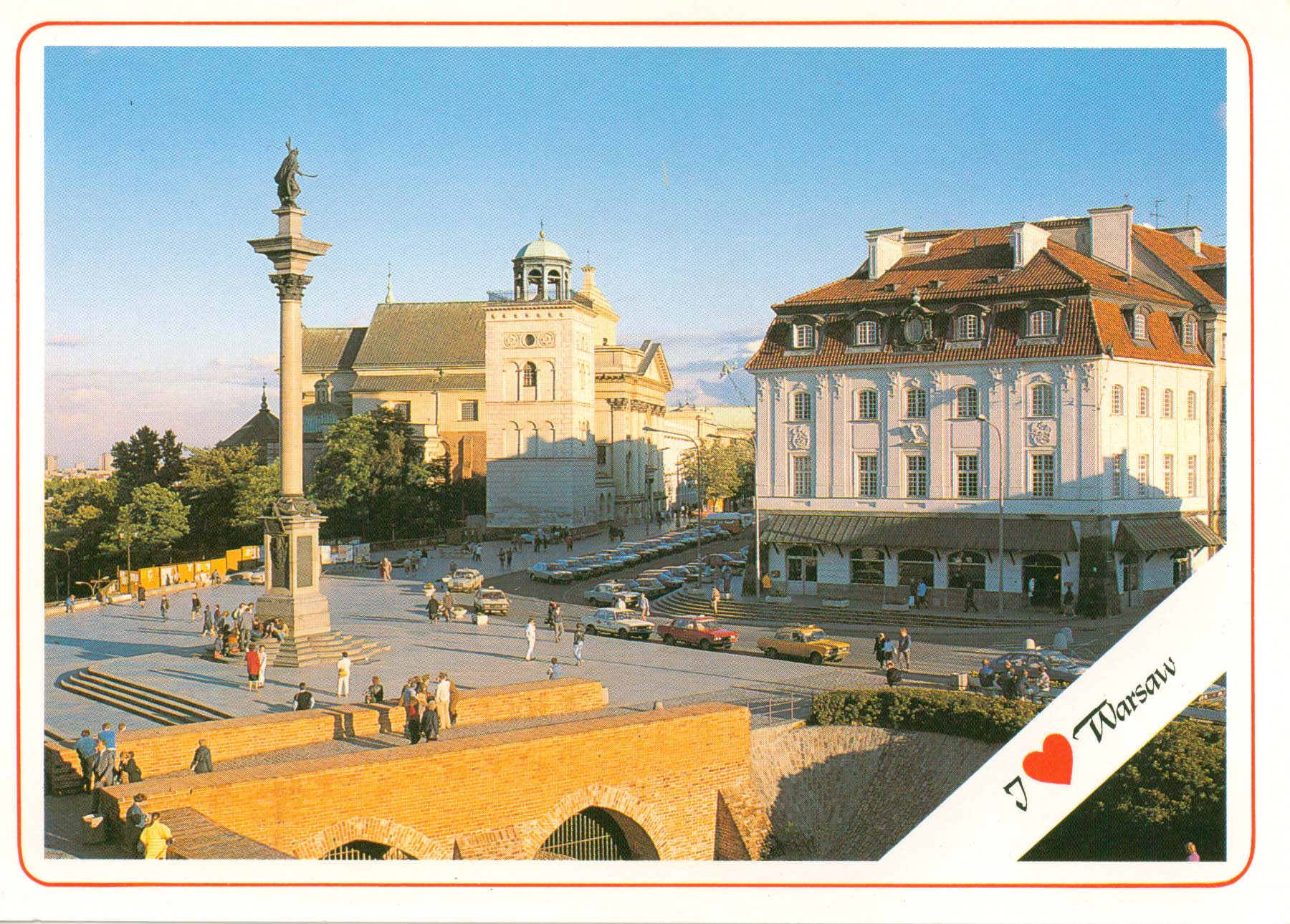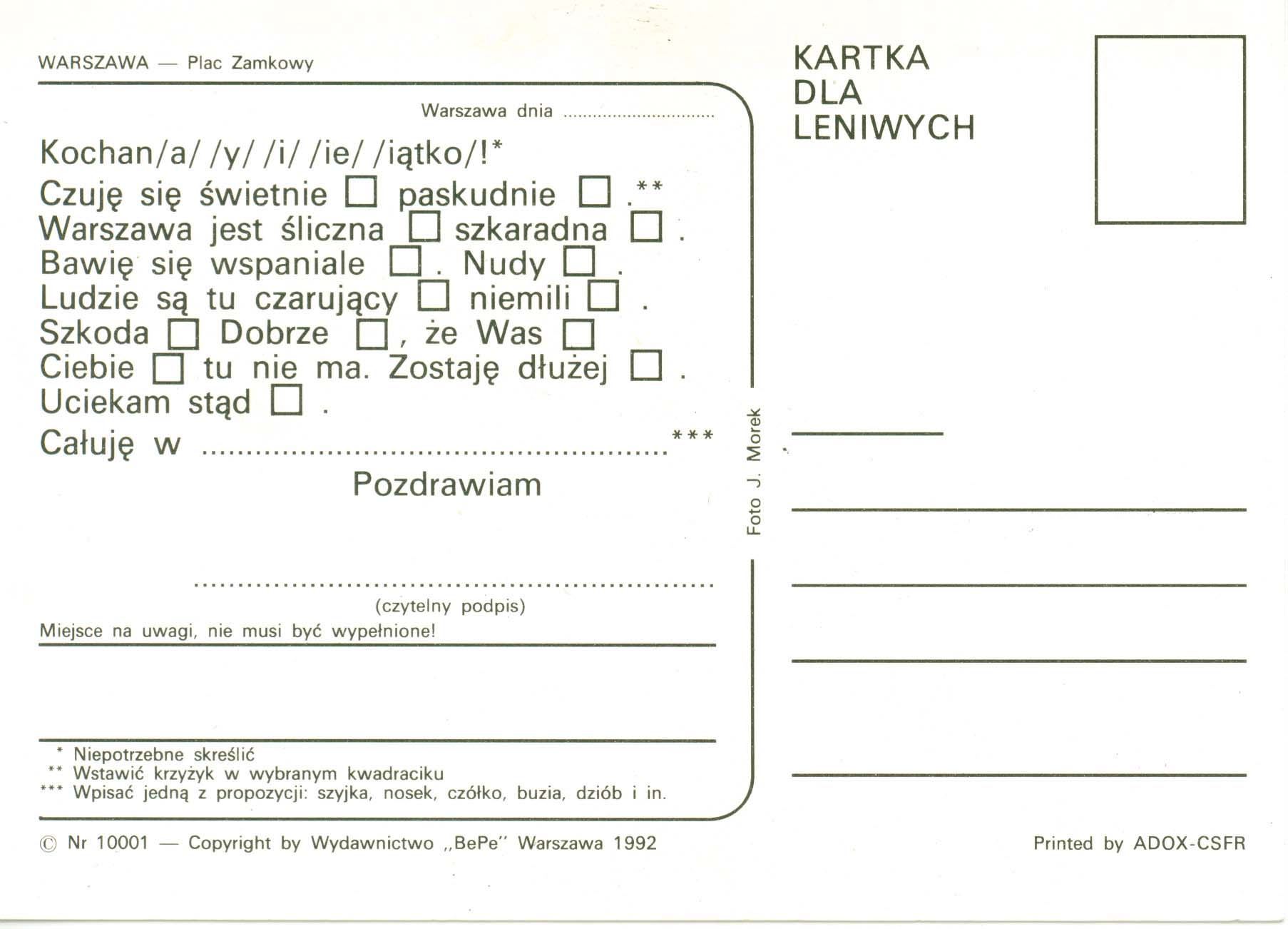Coortinates and text from Wikipedia, and Wikipedia. The back of the card is included, though I have no iead what it says; some sort of 'check boxes'
---
Zygmunt's Column - From Wikipedia, the free encyclopedia
--
Zygmunt's Column or Sigismund's Column (Polish: Kolumna Zygmunta), erected in 1644, is one of Warsaw's most famous landmarks and one of the oldest secular monuments in northern Europe. The column and statue commemorate King Zygmunt III Waza, who in 1596 had moved Poland's capital from Kraków to Warsaw.
Origins and design
Erected between 1643 and 1644, the column was constructed on the orders of Zygmunt's son and successor, King Wladyslaw IV Vasa. It was designed by the Italian-born architect Constantino Tencalla and the sculptor Clemente Molli, and cast by Daniel Tym. The Zygmunt's Column was modelled on the Italian columns in front of Basilica di Santa Maria Maggiore (erected in 1614 to designs of Carlo Maderno), and the Column of Phocas in Rome (Wladyslaw Vasa seen both of them during his visit to Rome in 1625).
In 1681 the monument was surrounded with a wooden fence, which was later replaced with a permanent iron fence. The marble column itself was renovated several times in the next few centuries, most notably in 1743, 1810, 1821 and 1828. In 1854 the monument was surrounded with a fountain featuring marble tritons sculpted by the German, August Kiss.
In 1863 the column was renovated somewhat again, but still needed work, and between 1885 and 1887 it was replaced with a new column of granite. Between 1927 and 1930, the monument was again renovated, and was restored to its original appearance when the fountain and the fence around it were removed.
On September 1, 1944, during the Warsaw Uprising, the monument was demolished by the Germans, and its bronze statue was badly damaged. After the war the statue was repaired, and in 1949 it was set up on a new column, made of granite from the Strzegom mine, a couple of meters from the original site. The original broken pieces of the column can still be seen lying next to the Royal Castle.
On the Corinthian column (which used to be of red marble), 8.5 m high, a sculpture of the King, 2.75-meter high, in archaistic armour is placed. Sigismund's Column now stands at 22 meters and is adorned by four eagles. The king is dressed in armor and carries a cross in one hand and wields a sword in the other.
The inscription
On the side of the pedestal facing the Krakowskie Przedmiescie is a plaque bearing the words in finest lettering reads:
HONORI·ET·PIETATI
SACRAM·STATVAM·HANC·SIGISMVNDO·III·VLADISLAVS·IV
NATURA·AMORE·GENIO·FILIVS
ELECTIONE·SERIE·FELICITATE·SVCCESSOR
VOTO·ANIMO·CVLTV·GRATVS
PATRI·PATRIAE·PARENTI·OPT: MER: ANNO·DNI·MDCXLIII
PONI·IVSSIT·CVI·IAM
GLORIA·TROPHEVM·POSTERITAS·GRATITVDInEM
AETERNITAS·MONVMENTVM·POSVIT·AVT·DEBET
-----
Tourist attractions - Warsaw Old Town - From Wikipedia, the free encyclopedia
--
Although today's Warsaw is a fairly young city, it has many tourist attractions. Apart from the Warsaw Old Town quarter, carefully reconstructed after World War II, each borough has something to offer. Among the most notable landmarks of the Old Town are the Royal Castle, King Zygmunt's Column, Market Square, and the Barbican.
Further south is the so-called Royal Route, with many classicist palaces, the Presidential Palace and the Warsaw University campus. Also the popular Nowy Swiat Street is worth mentioning. Wilanów Palace, the former royal residence of King John III Sobieski, is notable for its baroque architecture and beautiful parks.
Warsaw's oldest public park, the Saxon Garden, is located within 10 minutes' walk from the old town. Warsaw's biggest public park and said to be the most beautiful is the Royal Baths Park. It is also very old – established in the 17th century and given its current classical shape in late 18th century – is located further south, on the Royal Route, about 3 km (1.9 mi) from the Warsaw Old Town.
The Powazki Cemetery is one of the oldest cemeteries in Europe, full of sculptures, some of them by the most renowned Polish artists of the 19th and 20th centuries. Since it serves the religious communities of Warsaw, be it Catholics, Jews, Muslims or Protestants, it is often called a necropolis. Nearby is the Okopowa Street Jewish Cemetery, one of the largest Jewish cemeteries in Europe.
In many places in the city the Jewish culture and history resonates down through time. Among them the most notable are the Jewish theater, the Nozyk Synagogue, Janusz Korczak's Orphanage and the picturesque Prózna Street. The tragic pages of Warsaw’s history are commemorated in places such as the Monument to the Ghetto Heroes, the Umschlagplatz, fragments of the Ghetto wall on Sienna Street and a mound in memory of the Jewish Combat Organization.
There are also many places commemorating the heroic history of Warsaw. Pawiak, an infamous German Gestapo prison now occupied by a Mausoleum of Memory of Martyrdom and the museum, is only the beginning of a walk in the traces of Heroic City. The Warsaw Citadel, an impressive 19th century fortification built after the defeat of the November Uprising, was a place of martyr for the Poles. Another important monument, the statue of Little Insurgent located at the ramparts of the Old Town, commemorates the children who served as messengers and frontline troops in the Warsaw Uprising, while the impressive Warsaw Uprising Monument by Wincenty Kucma was erected in memory of the largest insurrection of World War II.
In Warsaw there are many places connected with the life and work of Fryderyk Chopin. The heart of Polish-born composer is sealed inside Warsaw's Holy Cross Church. During the summer time the Chopin Monument in the Royal Baths Park is a place where pianists give a concerts to the park audience.
Also many references to Marie Curie, her work and her family can be found in Warsaw: Marie's birthplace at the Warsaw New Town, the working places where she did her first scientific works and the Radium Institute at Wawelska Street for the research and the treatment of cancer which she founded in 1925.
-----
I <3 Warszawa

--
Warszawa - Plac Zamkowy
Kochan(a) (y) (i) (ie) (iako)!*
Czuje sie swietnie () paskudnie ()**
Warszawa jest sliczna () szkaradna ()
Bawie sie wspaniale () Nudy ()
Ludzie sa tu czarujacy () niemili ()
Szkoda () Dobrze (), ze Was () Ciebe ()to nie ma. Zostaje dluzej (). Uciekam stad ().
Caluje w (Poxdrawiam)***
(czytelny podpis)
Miejsce na uwagi, nie musi byc wypelnione!
*Niepotrzebne skreslic
**Wstawic krzyzyk w wybranym kwadraciku
***Wpisac jednq z propozycji; szyjka, nosek, czolko, buzia, dziob i in.
